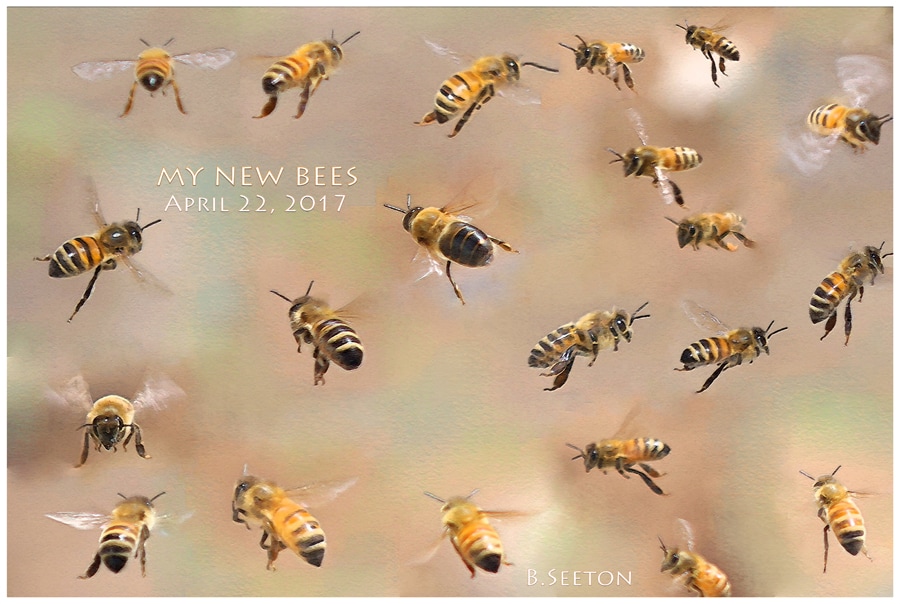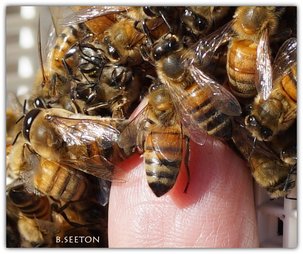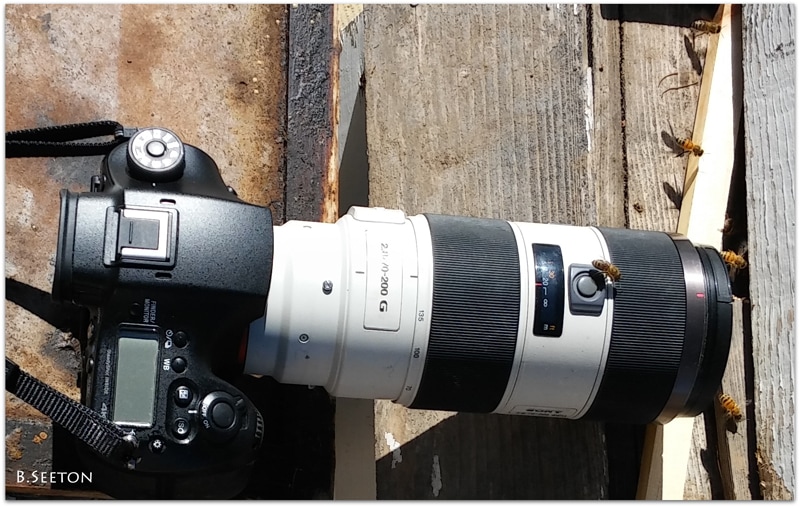I wanted to show a drone from yesterday, which is labeled The Boy Bee. Drones are bigger than the females with distinct coloring that is notably darker than the girls, and they have gold bands instead of dark stripes. Young bees will often be quite golden and have a "baby" look about them. I think they're quite cute.
|
I checked on their sugar water this morning, but it was chilly and never really warmed up all day. They weren't outside the hive much at all. I'm hoping they're okay, because the mass that was under the lid yesterday, (see yesterday's photos) wasn't there this morning. I'm assuming they were down along the frames perhaps to stay warm. It's supposed to rain/snow tomorrow and twice more this week. Not a a very welcoming weather pattern for the start of their season. I wanted to show a drone from yesterday, which is labeled The Boy Bee. Drones are bigger than the females with distinct coloring that is notably darker than the girls, and they have gold bands instead of dark stripes. Young bees will often be quite golden and have a "baby" look about them. I think they're quite cute. A close up of a drone from a previous season. I love their coloring.
1 Comment
BEE HAPPY I've never invested in a bee suit or veil. I started my bee-ventures when I stumbled upon a wild hive back in 2011. I got so used to being around wild bees that it never occurred to me to wear special clothing. I can tell by the sound of the bees if they're upset or if there's a worried bee that I should worry about. I have been stung fewer than a dozen times since 2011. I seem to react well to the stings, though I know that can change over time. I just love being with the bees and handling them; feeling their tiny feet and the vibration of their buzz. I welcome them to land on me. I put sugar water on my fingers today and had the bees lapping it up. Connecting with tiny life like this is part of who I am. I love connecting with all life in a very hands on way. Today, April 22, 2017, marks the start of my new bee season. I took my dog on the 2+ hour ride to pick them up and he sat with them for more than half the ride home. A symphony of non-stop buzz filled the car. I do love that sound. The hauler of the bees started to kill all the bees on the outside of my cage before he handed them to me. He called them collateral damage and apologized if I found it upsetting. I stopped him before he finished the slaughter and said I'd encourage the rest to fly off as I took possession of my bees. As I walked back to my car, a passerby asked me if I was talking to the bees. I said, "Yes." I'm thinking, "Of course, doesn't every beekeeper?" I'd been talking to the ones hanging on the outside. I let some crawl on my hand and told them they needed to find a new home. I gently blew at them, but I ended up with a half dozen who hitchhiked with us on the outside of the cage all the way home. I couldn't persuade them to stay. I hope they will be accepted into the hive. (The experts tell me they won't.) Coop put his nose right up to the temporary cage and licked the sides. He must have smelled the sugar water. The buzzing didn't bother him. I saw elk and hawks on the journey, and had my very first glimpse of a glossy ibis! (I think.) I watched him land in a hay field and pulled over to take pics, but he was so far away. He looked like a sandhill crane in the air. What caught my attention was the rust colored plumage. It is so wonderful being around bees again. I have never had what's called a package of bees, so I have never introduced them to their queen. I've only had mini hives already set up. I watched several how-to videos and chose a method of the several methods offered. The package consists of 3 pounds of honeybees. The queen is in a tiny finger size hollowed out piece of wood with a screen on the open side. Picture something 2 inches long and large enough to house one large bee. (I have a photo above.) One end of the piece of wood has a hole drilled through to the bee and it's stuffed with candy that bees like to eat. The bees have not met their queen and need time to adjust to her. One method of getting the bees into the hive from the travel box is to spray them with sugar water so they clump together, and then tap hard on the container held upside down with the opening facing the hive box. The bees are to fall into their new home. I opted to leave my bees in their travel box and pull out enough empty frames inside my langstroth hive to make room for the temporary box with the grand hope that the bees would leave their travel home on their own and set up shop inside the hive at their own pace. At first, I thought things were going to go smoothly. I set up the trough feeder (early spring is when bees need supplemental food) and set the queen between two frames so the other bees could meet her and eat at the candy plug. I sat outside at various times throughout the day spending time bonding and taking pictures. Hours later, toward four o'clock, I checked on the progress of "the move" and while a large number had exited to the frames, wayyy too many had not and it seemed like they decided their portable home might remain part of the hive. I didn't want that. So, I took out the travel box and attempted to shake the bees out. My sprayer of sugar water malfunctioned on the second spray, but I shook them anyway. I got some bees out. I then put the container by the front entrance of the hive box and gave it some more time to see if they would join the others on their own accord. I watched the time and the temperature closely. It was a warm day for our area; at 6 o'clock it hadn't fallen below 50 degrees F. I did some more shaking (or jolting in some instances) and got some more out. I'll never forget the sound of the swoosh as they were being tossed out. In one of the "shaking them out" times, I scooted them into the hive through the top hole when I didn't want to open the whole hive up because it was after 7 p.m.. I thought it might chill them. The remainder of the bees huddled together in their travel box after night came, and I went to bed thinking they might not make it, but I was hugely relieved to find them alive this morning in a softball size mass inside their container. I moved them into the sun and they rapidly began moving and flying. I hope 1) the wood floating on the feeder is effective in preventing drowning (I have serious doubts) 2) is the queen positioned securely between the frames and won't fall? 3) Will the remaining bees find their way into the hive today? 4) Will the bees accept their queen? 5) When will flowers/trees bloom enough to sustain them? I'm a nervous bee mom this morning. April 23rd. But first, I want to say how sweet this hive is. They remind me so much of my first hive. Not once yesterday did I hear the angry buzz I had with my hives last summer. I had the warning bumps yesterday, but not one sting. There wasn't ever a frenzied buzzing sound even though I know the long transport from California had to have been harrowing and very stressful, in addition to my transport yesterday. It'll be days before the girls acclimate to their new surroundings and only time will tell if they will accept the new queen. Once the candy plug is eaten, the queen will crawl out and be loved or killed. I'm using an open trough thing inside the hive filled with 1:1 sugar/water. Wood is placed in the trough to float so the bees won't drown, but I know it's not 100% effective and will need supervision. But here it is almost 4 p.m. - one full day since I got them -- and all seems good. Fingers crossed. I already love them. Since I'll be around my bees with my camera a lot, I put it near the hive and let them explore it.  To my bee friends who don't keep bees, can you pick out the drone in the photo? (Top Center) When I dove into the mass of bees this morning, I could feel their group warmth! This was the softball size huddled mass that spent the night outside in their travel home. I love being around their beauty! This mass of golden glossiness is gorgeous to me.
|
FOR ALL THE BEES
This blog will cover what I learn being a guardian of honey bees. I will also share with you about my connection with bees in ways that you won't often find in books or other sources.
For All The Animals (this website) is my company. Inspiring young people to learn about and love nature is very important to me.
I'm also a private investigator, writer, photographer and activist. Nature is my religion. One of my goals through the use of a camera lens is to bring the world of what I call "tiny life" into focus, to expand our own. I want to share my belief that all life matters. My photography passion extends to all animals, birds, marine life and reptiles. I posit that if the human race embraced that single concept -- all life matters -- we'd be closer to peace on this beautiful and glorious, but quite messed up planet. Archives
May 2017
Categories
All
|
















 RSS Feed
RSS Feed
